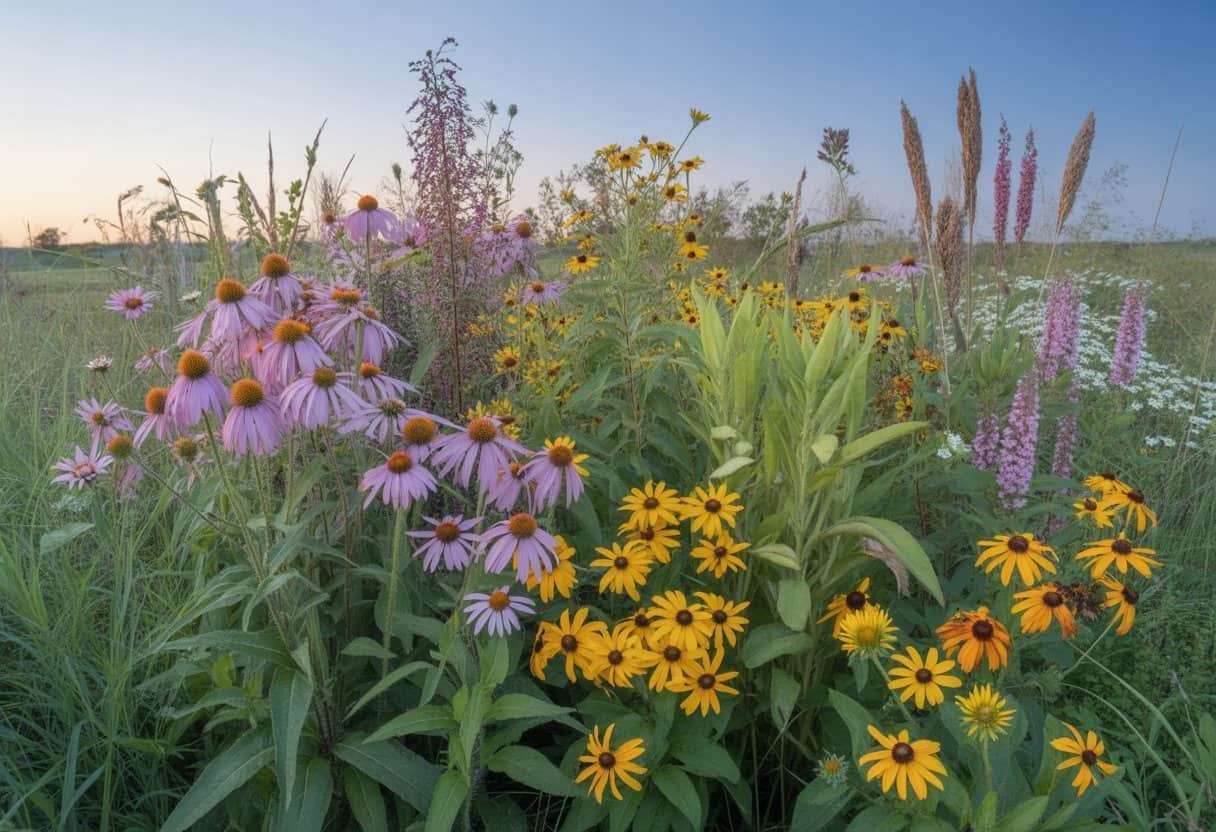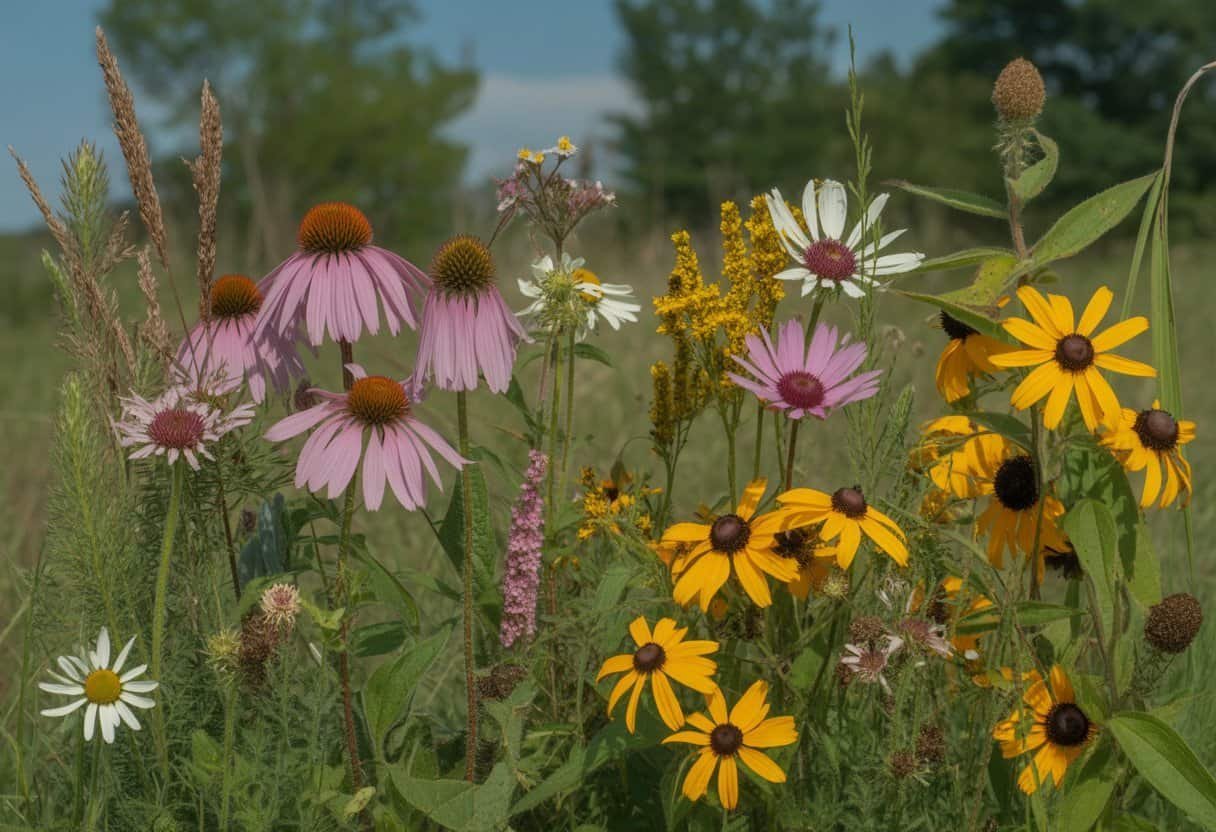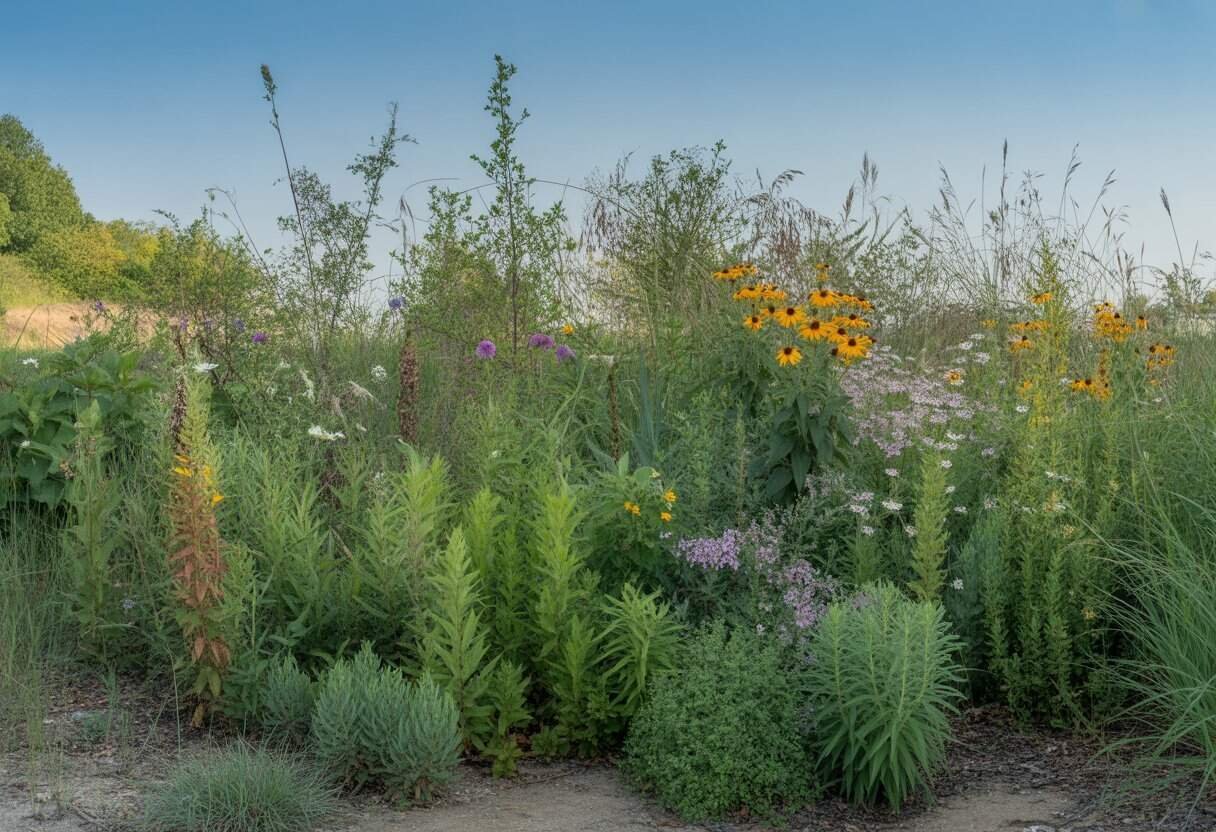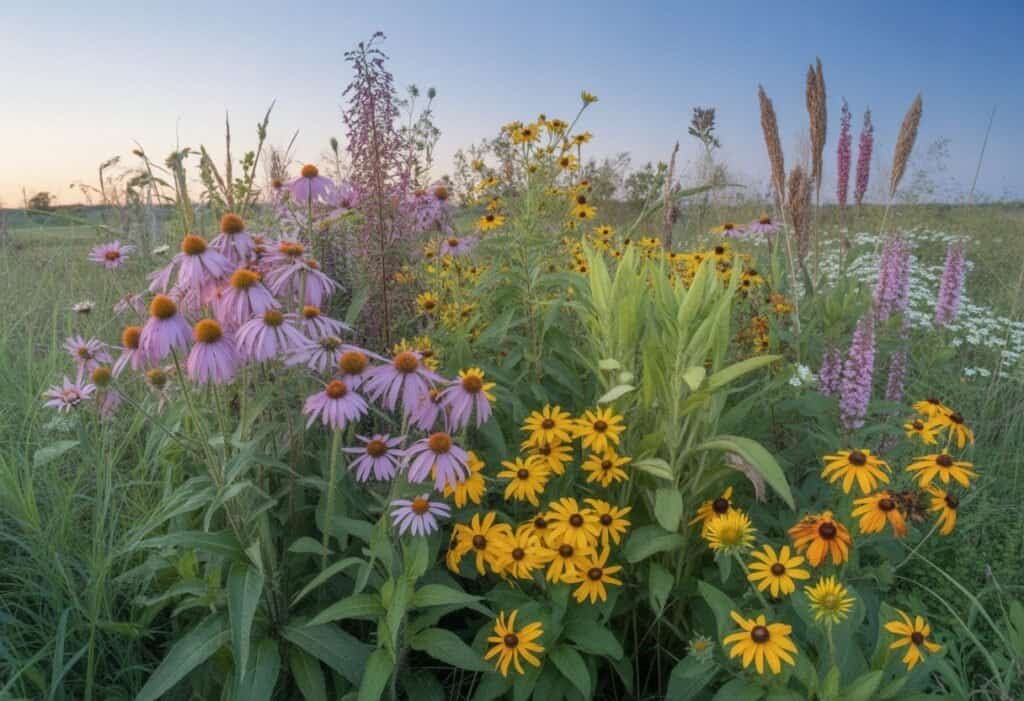Illinois native plants have thrived in our local ecosystems for thousands of years. These plants create the natural landscapes that make our state unique.
They have evolved alongside local wildlife, forming relationships that support birds, butterflies, and beneficial insects. Non-native plants cannot match this support.
Adding Illinois native plants to your garden creates a beautiful landscape. These plants also help restore biodiversity and ecological balance to your local environment.

From the towering oak trees that define our woodlands to the delicate prairie flowers that once covered millions of acres, Illinois offers an impressive variety of native plant species. These plants are perfectly adapted to our local climate and require less water, fertilizer, and maintenance than many exotic alternatives.
They have developed natural defenses against local pests and diseases. This makes them resilient choices for any garden.
Key Takeaways
- Illinois native plants support local wildlife while requiring less maintenance than non-native alternatives.
- Native plant gardens help restore biodiversity and ecological balance to urban and suburban environments.
- Local nurseries and conservation organizations offer resources to help homeowners incorporate native species into their landscapes.
Understanding Illinois Native Plants
Illinois native plants are species that naturally evolved in the region over thousands of years. They adapted perfectly to local soil conditions, climate, and wildlife.
These plants form the foundation of Illinois’ diverse ecosystems. They provide many benefits to both wildlife and humans.
Definition and Importance
Native plants in Illinois include any species that existed in the region before European settlement. The state has over 2,500 native plant species across its varied landscapes, from prairies and woodlands to wetlands.
These plants have developed complex relationships with local wildlife through centuries of coevolution. Native plants require less maintenance than non-native species once they become established.
They typically need less water, fertilizer, and pest control because they’ve adapted to local conditions. The vascular flora of Illinois represents an important botanical heritage.
Many native species serve practical purposes, including medicinal uses, food sources, and natural building materials. Preserving native plant knowledge connects Illinois residents to their natural and cultural history.
Biodiversity and Conservation
Illinois has lost more than 90% of its original natural habitats. Prairie habitats have been particularly impacted, with less than 0.01% of original prairie remaining.
Native plant conservation efforts focus on:
- Seed banking to preserve genetic diversity
- Restoration projects in degraded areas
- Public education about native plant importance
- Legal protection for rare and endangered species
The vascular flora of Illinois faces ongoing threats from development, invasive species, and climate change. Each lost native plant species potentially impacts dozens of wildlife species that depend on it.
Botanical gardens across Illinois maintain living collections of native plants. These efforts help safeguard biodiversity.
Ecological Benefits
Native plants provide essential habitat and food for local wildlife. A single oak tree can support over 500 species of moths and butterflies during their larval stages.
Illinois native plants contribute to:
- Soil stability and erosion control
- Carbon sequestration and climate resilience
- Water filtration and flood mitigation
- Pollinator habitat for bees, butterflies, and birds
Deep-rooted prairie plants can extend 15 feet or more underground. These roots create complex soil systems that improve water absorption and prevent runoff.
Native plant landscapes need fewer resources to maintain. Reducing pollution from mowing, fertilizers, and pesticides makes them environmentally and economically beneficial.
The diversity of native plant communities creates resilient ecosystems. These systems can better withstand environmental stresses and changing conditions.
Common Illinois Native Plant Species

Illinois has a rich diversity of native plants that thrive in the state’s unique climate and soil conditions. These plants provide essential habitat for local wildlife and add beauty to natural landscapes.
Wildflowers
Purple coneflower is one of Illinois’ most recognizable native wildflowers. It produces purple-pink flowers with raised orange-brown centers from June through July and attracts butterflies and bees.
Black-eyed Susan displays bright yellow flowers with dark centers and blooms throughout summer. These hardy plants thrive in prairie settings and sunny gardens.
Wild bergamot (Monarda fistulosa) produces fragrant lavender flowers in clusters during July. Hummingbirds often visit its aromatic blooms.
Lead plant (Amorpha canescens) features silver-gray foliage with purple flower spikes. This prairie species blooms in early summer and develops interesting fruits by fall.
White wild indigo offers white flowers in May and June. Its seed pods turn black and persist through winter, adding visual interest.
Grasses and Sedges
Big bluestem is the signature grass of Illinois prairies. This tall species can reach 6-8 feet in height and has distinctive purple-blue stems with turkey-foot seed heads in late summer.
Little bluestem grows in smaller clumps reaching 2-3 feet tall. Its blue-green summer foliage turns reddish-orange in fall, making it valuable for wildlife habitat and ornamental use.
Prairie dropseed forms tidy mounds of fine-textured foliage. This grass produces airy seed heads with a unique fragrance some describe as fresh popcorn.
Fox sedge thrives in wet areas and displays triangular stems with tan seed clusters. This adaptable plant helps prevent erosion along water edges.
Tussock sedge forms distinctive clumps in wetland areas. Its robust growth provides cover for small wildlife species and adds textural interest to moist landscapes.
Habitats and Growing Conditions

Illinois native plants have adapted to specific environments throughout the state’s diverse landscapes. These plants thrive in conditions that match their natural habitats.
Prairie and Meadow Environments
Prairie plants dominate Illinois’ natural landscape and need full sun exposure (6 or more hours daily) to flourish. These plants develop deep root systems that help them survive drought and stabilize soil.
Big bluestem, switchgrass, and prairie dropseed create the backbone of prairie gardens. They grow quickly once established and need minimal watering after the first year.
Coneflowers, black-eyed Susans, and blazing stars add vibrant colors and attract pollinators. These prairie flowers prefer well-drained soil and resist many common garden pests.
For home gardeners, prairie plants work well in sunny borders or dedicated meadow gardens. Annual mowing in early spring helps maintain these plants and prevents woody growth from taking over.
Woodlands and Shade Areas
Woodland natives thrive under tree canopies where they receive dappled sunlight or full shade. These plants have evolved to grow in cooler, moister environments with less direct sun.
Jack-in-the-pulpit, wild ginger, and bloodroot perform well in deep shade areas. They prefer rich, humus-filled soil that mimics forest floor conditions.
Woodland ferns like maidenhair and Christmas fern add texture and year-round interest. They grow best in protected locations away from harsh winds.
Many woodland plants bloom in early spring before trees leaf out fully. This adaptation allows them to capture sunlight when it’s most available.
Gardeners should avoid disturbing woodland plant roots. Adding leaf mulch annually helps recreate natural forest conditions.
These plants typically grow slower than their sun-loving counterparts.
Wetlands and Moisture Needs
Wetland plants thrive in areas with consistent moisture or periodic flooding. They play crucial roles in filtering water and preventing erosion along waterways.
Blue flag iris, swamp milkweed, and cardinal flower bring color to wet areas and support wildlife. These plants can tolerate standing water for short periods.
Sedges and rushes work well for rain gardens or low spots in yards. Their fibrous roots help absorb excess water after storms.
Many wetland plants attract beneficial insects and provide habitat for amphibians. For home landscapes, these moisture-loving plants work in rain gardens, along pond edges, or in areas with poor drainage.
They typically require less maintenance in locations that naturally collect water.
Soil Types and Preparation
Illinois soils vary widely from clay-heavy in the north to sandier compositions in the south. Native plants have evolved to thrive in these specific soil conditions.
Clay soils benefit from adding organic matter before planting natives. This improves drainage and prevents root rot except for the most water-tolerant species.
Sandy soils may need extra organic material to improve moisture retention. Many prairie plants actually prefer these quick-draining conditions.
Soil pH affects nutrient availability for plants. Most Illinois natives prefer slightly acidic to neutral soils (pH 5.5-7.0).
Before planting, test your soil and amend only as needed. Many natives perform better in less fertile soil, which prevents excessive growth and reduces maintenance needs.
Illinois Native Plants for Pollinators and Wildlife
Native Illinois plants provide essential food and shelter for local wildlife. They help create sustainable ecosystems in your garden.
These plants have evolved alongside local species, making them well suited to support the region’s biodiversity.
Attracting Pollinators
Illinois native plants excel at drawing in bees, butterflies, and other pollinators. Purple coneflower (Echinacea purpurea) produces abundant nectar throughout summer and becomes a pollinator hotspot in any garden.
Wild bergamot (Monarda fistulosa) attracts bumblebees and butterflies with its aromatic flowers and lavender blooms.
For late-season pollinators, goldenrod (Solidago species) offers critical food when other plants have finished flowering. Goldenrod’s heavy pollen does not travel by air and does not cause allergies.
Some top Illinois pollinator plants include:
- New England aster
- Butterfly weed
- Prairie blazing star
- Wild lupine
- Cardinal flower (especially for hummingbirds)
Supporting Birds and Butterflies
Native plants form the foundation of habitat for Illinois birds and butterflies. Milkweed (Asclepias species) serves as the exclusive host plant for monarch butterfly caterpillars and provides nectar for many adult butterflies.
Berry-producing natives like serviceberry (Amelanchier) and elderberry (Sambucus canadensis) provide essential food for birds. These plants also offer habitat for the insects birds feed to their young.
Joe-Pye weed (Eutrochium purpureum) grows tall with purple flower clusters that attract swallowtail butterflies. Black-eyed Susan (Rudbeckia hirta) produces seeds that goldfinches and chickadees eat during fall and winter.
Plant native grasses like little bluestem to provide nesting material and shelter for ground-nesting birds.
Enhancing Habitat Diversity
Creating diverse plantings with multiple native species maximizes wildlife benefits in your garden. Include plants with different bloom times to provide nectar sources from spring through fall.
Layering vegetation creates more opportunities for wildlife. Oak trees support over 500 caterpillar species, making them biodiversity champions.
Beneath them, shrubs like American hazelnut provide midlevel habitat and food. Leave some leaf litter and dead stems in garden beds as overwintering sites for beneficial insects.
This natural debris becomes critical habitat for many species. Water features complement native plantings and complete your wildlife habitat.
Even a small birdbath or shallow dish provides drinking water for pollinators during dry periods.
Try these combinations for maximum biodiversity:
- Woodland edge: redbud trees, wild geranium, and Virginia bluebells
- Prairie garden: compass plant, purple prairie clover, and prairie dropseed
- Wet area: swamp milkweed, blue flag iris, and fox sedge
Designing and Planting Illinois Native Gardens
Creating a garden with Illinois native plants requires thoughtful planning and design. Native gardens offer beauty throughout the seasons and provide essential habitat for local wildlife.
They also require less maintenance than conventional landscapes.
Garden Layout and Planning
Start by assessing your site’s sun exposure, soil type, and moisture levels. Map your yard on paper and note existing structures and plants you want to keep.
Group plants with similar needs together. This creates ecological communities that naturally occur in Illinois.
Place taller plants at the back of beds and shorter ones in front. Plant in clusters of 3-5 of the same species for visual impact and to mimic natural plant communities.
Consider pathways and viewing areas in your design. Make the garden accessible and enjoyable.
Include seating areas to observe wildlife attracted to your native plants.
Seasonal Considerations
Plan your garden to provide interest in every season. Spring bloomers like Jacob’s ladder and wild columbine offer early color.
Summer brings showy flowers such as purple coneflower and black-eyed Susan. Fall color comes from both flowers and foliage.
Asters and goldenrod bloom in fall, while little bluestem grass turns a rusty-orange. Many native plants add winter interest with their seed heads and silhouettes.
Stagger bloom times throughout your planting plan. This ensures continuous color and a steady food source for pollinators.
Include at least three plants for each season. This maintains visual interest all year.
Combining Color and Texture
Combine plants with complementary colors and contrasting textures for visual harmony. Use this basic color palette for Illinois natives:
| Season | Color Combinations |
|---|---|
| Spring | Blue, white, yellow |
| Summer | Purple, yellow, orange |
| Fall | Purple, yellow, red |
Mix plants with different leaf shapes and sizes to add texture. Pair the fine texture of prairie dropseed grass with the bold leaves of wild bergamot.
Use plants with interesting forms as focal points. The structure of rattlesnake master or compass plant adds drama to the garden.
Repeat certain plants or colors throughout the garden to create rhythm and cohesion.
Sources for Illinois Native Plants
You can find quality native plants for your Illinois garden at reliable sources. These resources help you locate authentic Illinois natives, identify them, and learn about their growth needs.
Reputable Plant Nurseries
Several specialized nurseries in Illinois focus on native plants. Possibility Place Nursery in Monee offers a wide selection of prairie plants, shrubs, and trees native to the region.
Prairie Moon Nursery provides seeds and plants with detailed growing information. In central Illinois, Illinois Native Plant Source near Champaign specializes in prairie, woodland, and wetland species.
Many nurseries host seasonal plant sales in spring and fall. Wild Ones organization chapters often organize these events where you can find rare native species.
Always verify that plants are true Illinois natives. Ask nursery staff about the origin of their plant stock.
Field Guides and Resources
Plants of the Chicago Region by Swink and Wilhelm is a comprehensive field guide for Illinois native plants. It includes habitat information and plant communities.
The Illinois Wildflowers website provides photos, common names, and scientific details about hundreds of native species. Each entry lists bloom time, growing conditions, and wildlife value.
Native Plants Journal publishes research and practical information for growing native species. Many issues focus on Midwestern plants.
Apps like iNaturalist help with plant identification in the field. Users can upload photos and get identification help from experts.
The Morton Arboretum website offers planting guides specific to Illinois regions and soil types.
Illinois Natural History Survey
The Illinois Natural History Survey (INHS) in Champaign serves as a primary resource for native plant information. Their herbarium contains over 270,000 plant specimens collected throughout Illinois.
INHS researchers publish studies on Illinois ecosystems and plant communities. Their website features identification guides with detailed photos of native species by habitat type.
The survey offers workshops on plant identification and restoration techniques. These hands-on sessions help gardeners recognize native species at different growth stages.
INHS also runs a rare plant monitoring program that tracks endangered species. Their newsletter provides updates on conservation efforts and new discoveries about Illinois native plants.
The survey’s botanists can help identify unusual plants through their identification service.
Regional Context and History
Illinois native plants evolved within a unique geographical and historical context. This history shaped their diversity and distribution.
Historical Overview of Native Flora
Native plants in Illinois thrived for millennia before European settlement. Prairie ecosystems dominated the landscape, covering nearly 60% of the state with tall grasses and wildflowers.
These prairies formed over 8,000 years ago after the last ice age. Native Americans, especially the Illinois Confederation tribes, managed these landscapes with controlled burns.
These practices promoted the growth of plants like compass plant and purple coneflower, which they used for medicine and food. European settlement in the 1800s changed Illinois vegetation.
Settlers converted prairies to farmland rapidly. By 1900, less than 1% of original prairie remained.
Hay production became a major agricultural focus in the 19th century. Farmers replaced native grasses with introduced species, further reducing native plant populations and altering soil conditions.
Illinois and Surrounding States
Illinois shares botanical communities with neighboring states. The Mississippi and Ohio Rivers act as boundaries and corridors for plant migration.
Missouri influences Illinois’ western counties, where drought-tolerant prairie species cross the Mississippi. Kentucky and southern Indiana contribute Appalachian species to southern Illinois, creating unique woodland communities in the Shawnee Hills.
Northern Illinois shares flora with Wisconsin, featuring northern hardwood forests and wetland communities. These regional connections show how plant distributions cross political boundaries.
Illinois has unique plant communities due to its central position. Here, eastern forests meet western prairies, creating a botanical crossroads.
This geographic position explains why Illinois hosts over 2,200 native plant species.
Frequently Asked Questions
Illinois native plants offer solutions for many common gardening challenges. They adapt well to local conditions and benefit both people and wildlife.
What are the best Illinois native plants to use for home landscaping?
Purple coneflower (Echinacea purpurea) thrives in Illinois gardens with its purple blooms and drought tolerance. This perennial attracts butterflies and provides winter interest with its seed heads.
Wild bergamot (Monarda fistulosa) produces lavender flowers that attract hummingbirds and butterflies. It grows well in various soil conditions and adds fragrance to gardens.
Little bluestem (Schizachyrium scoparium) offers year-round interest with blue-green summer foliage that turns rusty-red in fall. This native grass provides excellent winter structure.
Black-eyed Susan (Rudbeckia hirta) delivers bright yellow flowers from June through October. It’s easy to grow and self-seeds readily in sunny locations.
Where can one purchase native plant species in Illinois?
Native plant nurseries such as Possibility Place in Monee and Prairie Moon Nursery (online) specialize in Illinois natives. These businesses offer expertise along with their plants.
Many county conservation districts hold annual native plant sales in spring. These events usually feature locally grown plants at reasonable prices.
The Illinois Native Plant Society chapters often organize plant exchanges and sales. Their events connect gardeners with hard-to-find native species.
Some garden centers now carry sections dedicated to native plants. Ask staff specifically for plants native to Illinois.
How can Illinois native plants be beneficial for local pollinators?
Cardinal flower (Lobelia cardinalis) provides nectar for hummingbirds with its red tubular blooms. Few other plants attract these pollinators as effectively.
Milkweed species (Asclepias) serve as the only host plant for monarch butterfly caterpillars. Their flowers also provide nectar for many adult butterflies and bees.
Native asters and goldenrods bloom in late summer and fall. This timing provides food for pollinators preparing for winter.
Native plants and local pollinators evolved together, creating specialized relationships. The flower shapes, colors, and bloom times match the needs of Illinois bees, butterflies, and birds.
Which native evergreen species are found in the state of Illinois?
Eastern red cedar (Juniperus virginiana) is Illinois’ most common native evergreen tree. It adapts to various conditions and provides winter shelter for birds.
White pine (Pinus strobus) grows naturally in northern Illinois. Its soft needles and graceful form make it an attractive landscape choice.
American holly (Ilex opaca) offers year-round green foliage and bright red berries in winter. It prefers partial shade and acidic soils.
Creeping juniper (Juniperus horizontalis) serves as a low-growing evergreen ground cover. It thrives in sunny, dry locations where other plants struggle.
Can you recommend any native ground cover plants suitable for Illinois gardens?
Wild ginger (Asarum canadense) creates a dense carpet of heart-shaped leaves in shady areas. This slow-spreading plant remains evergreen in mild winters.
Pennsylvania sedge (Carex pensylvanica) forms soft mounds of grass-like foliage. It tolerates dry shade, making it perfect for difficult spots under trees.
Prairie dropseed (Sporobolus heterolepis) forms neat clumps of fine-textured foliage. Its arching leaves catch morning dew and create beautiful patterns in the landscape.
Wild strawberry (Fragaria virginiana) spreads by runners to create a low mat of foliage. The spring flowers develop into small, sweet berries enjoyed by birds and humans.
What resources are available for identifying native plants in Illinois?
The Illinois Wildflowers website provides detailed information and photographs of native plants. It also lists growing conditions, wildlife benefits, and similar species.
“Plants of the Chicago Region” by Swink and Wilhelm is a key reference book. It covers native plants and their habitats.
The Morton Arboretum offers online plant identification tools. They also provide on-site classes.
Their experts help identify unknown specimens. They can suggest native alternatives.
iNaturalist’s mobile app lets users photograph plants for identification. Experts in the community review submissions and confirm plant identities.


